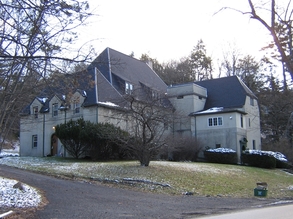|
Tuttle Apartments
107 Cayuga Heights Road Year Built: 1923 Style: French Chateau In 1922, Elbert Parr Tuttle (1897-1996), then a busy Cornell law student and young father, noticed that there were very few apartments to rent in Ithaca. So the enterprising student decided to fill the need. He purchased an empty lot on Cayuga Heights Road from builder Jes J. Dall and his wife Mary Alice Dall.
|
Tuttle and his wife Sara Sutherland Tuttle (1898-1994) hired a recent Cornell architecture grad* to design an apartment building in a French Eclectic style. It became known as Tuttle Apartments, and Cornell professors and their spouses were the first tenants. (An architectural rendering of the building, along with an early photograph of the elegant exterior, are included in the Cornell Law School Heritage Project's filmed interview series of the Tuttles.)
|
Tuttle “rented one of the apartments to Professor Charles K. Burdick of the Cornell Law School,” recalled Arthur Dean, Tuttle’s law school classmate and fellow editor of the Cornell law review. “His problems in not wishing to offend a beloved teacher, while sticking up for his rights as a landlord, somewhat complicated his student and editorial life.”
|
Indeed, the story goes that Professor Burdick interrupted Tuttle while he was taking an exam to ask if his wife could call a plumber to fix a clogged sink. The Tuttle Apartments, remarked another legal colleague somewhat tongue-in-cheek, “stand as a tribute to [Tuttle’s] enterprise, diplomacy, and creative problem solving abilities.”
Elbert, Sara, and their son Elbert "Buddy" Jr. lived in one of the newly built apartments before graduation in 1923. The family subsequently moved to Atlanta, Georgia, where the top Cornell law graduate began his legal career. The Tuttles gave up their landlord roles when they sold Tuttle Apartments in 1938.
In his early decades as a lawyer, Tuttle took on several civil rights cases in the South, notably rescuing an accused Georgia man from a mob and filing an appeal for a new trial based on due process issues. After World War II began, Tuttle took a leave from his law firm and enlisted, receiving a Bronze Star, Legion of Merit, Purple Heart with Oak Leaf Cluster, and Bronze Service Arrowhead.
In the mid-1950s, just after the landmark school desegregation case Brown v. Board of Education, Tuttle was named a federal judge to the U.S. Court of Appeals for the Fifth Circuit. His rulings as chief judge throughout the critical decade of the 1960s helped dismantle Jim Crow laws in the South. In 1980, Tuttle was awarded the Presidential Medal of Freedom. Calling Judge Tuttle “a true judicial hero,” President Carter explained: “At a time when it was unpopular to do so, he carried out the mandate of Supreme Court decisions and Congressional legislation to end racial discrimination in the Deep South. With steadfast courage and a deep love and understanding of the region, he has helped to make the Constitutional principle of equal protection a reality of American life.”
Patricia Longoria
Deputy Historian, Village of Cayuga Heights
Deputy Historian, Village of Cayuga Heights
* Note: It's possible that the Cornell architecture graduate who designed the Tuttle Apartments is J. Lakin Baldridge. Baldridge graduated from Cornell with a Master's degree in architecture in 1922, the same year that the Tuttles purchased the lot on Cayuga Heights Road. Baldridge was a partner of builder Jes Dall, who sold the lot to the Tuttles. Baldridge and Dall went on to build many notable homes in Cayuga Heights until Baldridge's early retirement in the 1930s.
Sources:
- Aman, Alfred C. Jr., “Elbert Parr Tuttle,” Cornell Law Review, Volume 82, Issue 1, November 1996, Article 1.
- Cornell University Law School Heritage Project, "Tuttle, Elbert P," May 15, 1988, various video clips.
- Dean, Arthur H., “Tribute to Chief Judge Elbert P. Tuttle,” Cornell Law Review, Volume 53, Issue 1, November 1967, Article 1.
- Emanuel, Anne, Elbert Parr Tuttle: Chief Jurist of the Civil Rights Revolution. University of Georgia Press. 2014.
- Carter, Jimmy , “Presidential Medal of Freedom Remarks at the Presentation Ceremony,” January 16, 1981. Online by Gerhard Peters and John T. Woolley, The American Presidency Project. http://www.presidency.ucsb.edu/ws/?pid=44540.
- Elson, Charles M., “Remembering Judge Elbert P. Tuttle Sr.,” Volume 82, Issue 1, November 1996, Article 2.
- Shaw, Michelle E., “Dr. Elbert P. Tuttle Jr., 90: Dedicated doctor and lifelong learner,” The Atlanta Journal Constitution, Friday, March 23, 2012.
- Steely, Mel. "Elbert Parr Tuttle (1897-1996)." New Georgia Encyclopedia. 07 August 2013. Web. 19 August 2016, http://www.georgiaencyclopedia.org/articles/history-archaeology/elbert-parr-tuttle-1897-1996.
- Tompkins County Clerk’s Office Deed Book 203, Page 109; November 19, 1922. (Guy H. Tuttle, Elbert’s father, is also on the deed and is listed as “owner of an undivided nine-fourteenths of the premises,” compared to Elbert’s five-fourteenth’s share.); Tompkins County Clerk’s Office Deed Book 249, Page 436; December 24, 1938.
- Totenberg, Nina, “Elbert Tuttle, Quiet Civil Rights ‘Revolutionary,’” NPR Books, October 5, 2011.


